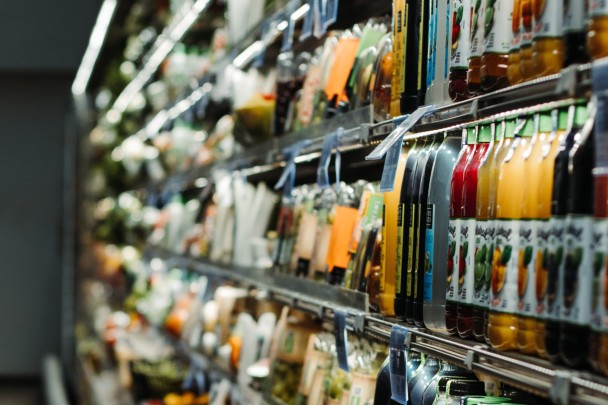June 30, 2022 Industry news
With the implementation date fast approaching, GS1 UK has partnered with leading trade bodies, the Food and Drink Federation (FDF) and the British Retail Consortium (BRC), to provide expert guidance and help businesses prepare.
Our recent webinar featuring Andrea Martinez-Inchausti, the BRC’s deputy director for food policy, and Louise Allen, senior executive of diet and health at the FDF, covered various aspects of the upcoming regulations that affected businesses will need to consider, including;
- Whether your business will be liable
- Clarifying the scope of the regulations
- How to identify if your products are in scope
- How to calculate the nutrient profiling model ‘HFSS’ score

How will these restrictions affect you?
Part one of the webinar, saw Andrea Martinez-Inchausti give a presentation on the regulations for England and the products currently in scope.
Andrea previously led the joint project with the Department of Health to deliver the front of pack nutrition labelling scheme and is currently working on the implementation of the new provisions restricting price promotion and product placement.
Agreed in parliament in December 2021, The Food (Promotion and Placement) (England) Regulations were published in April 2022 along with a set of guidance produced by the Department of Health.
If your business produces or supplies food and drink, you may have already received requests for product data from your retailers as they will be fully responsible for the application of the in-store restrictions that will come into force from October 2022.
However, you still need to understand how this will affect your business so Andrea recommends taking that time to familiarise yourself with both the regulations and the supporting guidance which, to summarise, currently covers:
Volume promotions
Currently postponed until 2023, the government’s HFSS legislation will ban the following volume promotions in order to prevent consumers leaving stores with more unhealthy products than they need or intended to buy:
- Multibuy deals (e.g. BOGOF, buy 6 save 25%)
- “Extra free” offers (e.g. 50% extra free)
- Loyalty points offers or discounts (e.g. buy 3 get 1000 points)
This includes promotion with non-specified food or drink products.
Location promotions
Still set to come into force from October 2022, these restrictions will see HFSS products banned from the following locations in order to reduce their visibility:
- Within the prohibited distance of a store entrance (dependent on the size of the premises)
- Covered external areas
- Within two metres of any checkout facility
- Within two metres of any designated queuing area
- On and within 50cm of aisles ends in main customer routes
While the online restrictions, intended to replicate the restrictions in-store will HFSS products from from:
- Home pages
- Search/browse results for HFSS products or other HFSS categories
- Cross promotion of HFSS products
- “Favourite product” and “recommended for you” pages (some exemptions apply)
- Checkout pages
Products in scope
To establish if a product is in scope, there are four criteria that all need to be met. These include:

1. Where is the product sold?
Not all stores will be affected. The restrictions will apply to stores over 2,000 square feet, retailers with more than 50 employees or symbol group franchisees with more than 50 employees operating under that business name.
Both small businesses with less than 50 employees, and specialist retailers that only sell one category of product (e.g. chocolatier) with small stores (less than 2,000 square feet) are exempt from the ban on location promotions.
2. Is the product pre-packed?
In the context of HFSS, ‘Pre-packaged food’ covers any item of food that is enclosed, either completely or partially, and the contents of which cannot be altered without opening or changing the packaging. Prepacked food does not cover foods packed on the sales premises at the consumer’s request or prepacked for direct sale. Anything sold loose or prepared for direct sale is out of scope.
3. Is the product HFSS?
Whether or not a product is high in fat, salt or sugar depends on the on the Department of Health’s (DoH) nutrient profiling model, which compares energy, saturated fat, total sugar and sodium against fruit, vegetables and nut content, fibre and protein.
4. Is the product in a category of foods in scope
The restrictions will apply to 13 categories of food that are significant contributors to sugar and calorie intakes and which are heavily promoted. These include:
- Soft drinks with added sugars
- Crisps and savoury snacks
- Breakfast cereals
- Confectionary
- Ice creams & ice lollies
- Cakes
- Biscuits
- Breakfast bakery
- Deserts & puddings
- Yoghurt
- Pizza
- Potato-based products
- Ready Meals
Despite their nutrient profile score, there are also a number of product categories that are not covered by the legislation, such as:
- Condiments, dips and sauces
- Meat, fish and poultry (unless specified) – including processed meats
- Pies and savoury pastries
- Cheese
- Cooking sauces
- Savoury crackers (not sold in individual packs)
- Fruit, veg and nuts (including salted)
- Baby food
- Packaged sandwiches, sushi and salads
- Beers, wines and spirits
Of course there is still some room for interpretation when it comes to the categories listed above so, if you have any doubts, you should always refer back to the full regulations and guidance documents.

How to calculate your nutrient profiling ‘HFSS’ score
In part two, Louise Allen, the food and drink federation's (FDF) senior executive of diet and health explained how to calculate the nutrient profiling score and determine if a products is ‘HFSS’.
Developed in 2005 by a panel of experts commissioned by the Food Standards Agency (FSA), the nutrient profile model is currently used to determine whether or not a product is high in fat, salt or sugar.
Since 2007, the model has been used to restrict advertising to children on television and, since 2017, has also been applied to similar advertising in non-broadcast media.
Under the new HFSS legislation, nutrient profile scores will be used to determine whether products will be subject to:
- Restrictions on location in store and online from October 2022
- Restrictions multibuy offers in store and online from October 2023
- Further restrictions on TV and paid-for online advertising from January 2024
Calculating the score
The Nutrient Profile Model uses a point scoring system. Points are allocated per 100g, irrespective of the serving size, to determine a score for a range of components.
Points are awarded for ‘A’ nutrients (energy, saturated fat, total sugar and sodium) and for ‘C’ nutrients (fruit, vegetables and nut content, fibre and protein) which are then subtracted from the score for ‘A’ nutrients to give the final nutrient profile score (NPS). Foods scoring 4 or more points and drinks scoring 1 or more points are classified as HFSS.
Basically, you need to apply the following formula to a 100 gram sample of your product using the points system displayed in the tables on the left. :
Total ‘A’ points (energy + sat fat + sugars + sodium) MINUS total ‘C’ points (Fruit, veg and nuts + fibre + protein) EQUALS the final NPS score
If a product needs to be reconstituted before it is eaten, the points used to calculated the score should based on how it would be eaten/served.
There is also a “protein cap” designed to safeguard against products high in protein being classified as healthier than they truly are. This means that if a product scores 11 or more ‘A’ points, you cannot deduct any ‘c’ points for protein. However, gf you product is more than eighty percent fruit, veg or nuts (scoring five points of more for these nutrients) then the protein cap does not apply, regardless of how many A points it has.
Louise echoed Andreas advice that if you are unsure of anything, always go back and check the official guidance. She also reminded viewers that the nutrient profile model is now 11 years old and due to be updated by the Department of Health and Social Care. While you still need to use the existing model to work out your NPS score, do keep an eye out for further government announcements.
HFSS resources

productDNA for HFSS
We have collaborated with leading retailers to create a free HFSS solution through our productDNA platform. Easily manage and share HFSS product data to multiple retailers in one action.
